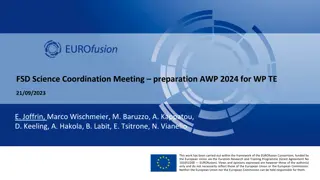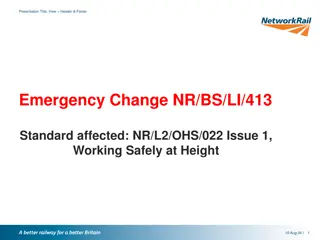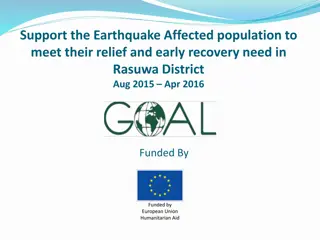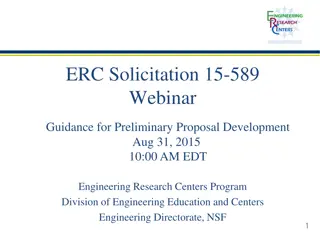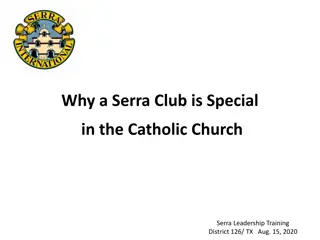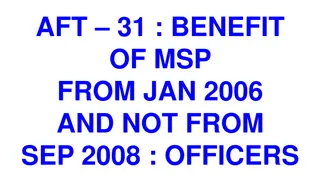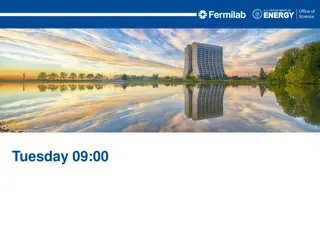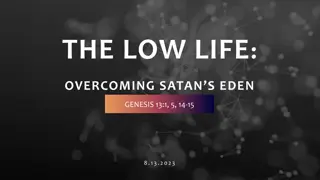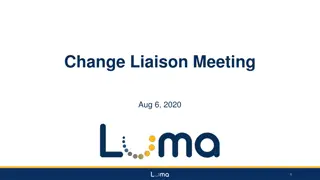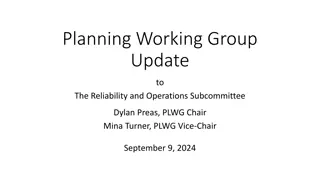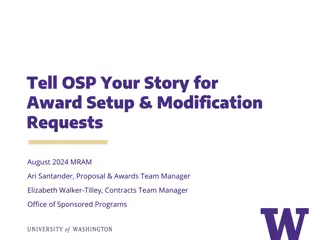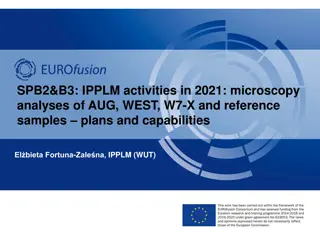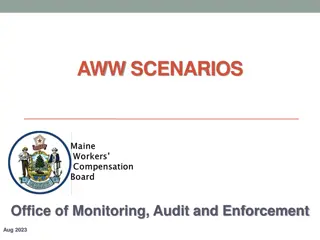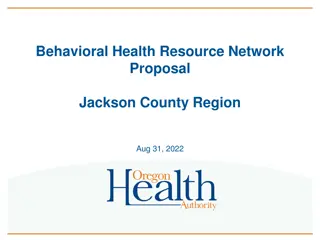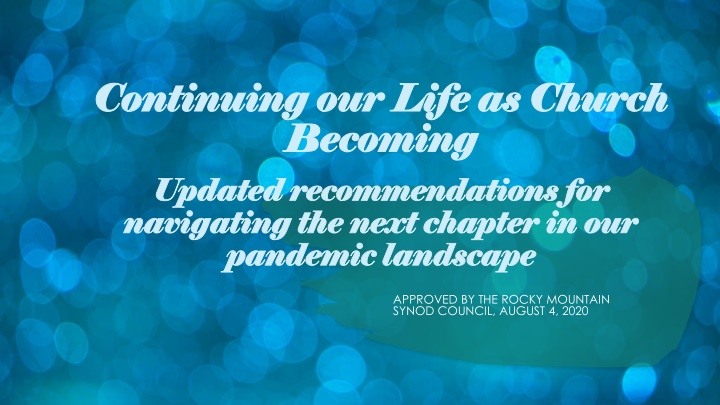
Navigating Corporate Worship in the Pandemic Landscape
Explore updated recommendations for navigating the next chapter in the pandemic landscape, focusing on prioritizing safe, accessible, and meaningful worship opportunities. With an emphasis on online platforms and considerations for equipment and content, adaptability is key for congregations and communities of faith.
Download Presentation

Please find below an Image/Link to download the presentation.
The content on the website is provided AS IS for your information and personal use only. It may not be sold, licensed, or shared on other websites without obtaining consent from the author. If you encounter any issues during the download, it is possible that the publisher has removed the file from their server.
You are allowed to download the files provided on this website for personal or commercial use, subject to the condition that they are used lawfully. All files are the property of their respective owners.
The content on the website is provided AS IS for your information and personal use only. It may not be sold, licensed, or shared on other websites without obtaining consent from the author.
E N D
Presentation Transcript
Continuing our Life as Church Continuing our Life as Church Becoming Becoming Updated recommendations for Updated recommendations for navigating the next chapter in our navigating the next chapter in our pandemic landscape pandemic landscape APPROVED BY THE ROCKY MOUNTAIN SYNOD COUNCIL, AUGUST 4, 2020
Gratitu Gratitu de de and Grace and Grace
RECOMMENDATION ONE: It is recommended that congregations and communities of faith continue to prioritize worship opportunities that are safe, accessible, invitational, meaningful, and sustainable. The use of an online/digital platform remains the highest recommended format for corporate worship through at least the end of the calendar year. Any in-person worship experience should prioritize an outdoor venue, small groups, physical distancing, and the use of face coverings. There is a strong likelihood that corporate in-person worship that is able to include all parishioners inside of a church building will not be advisable well into 2021.
This recommendation about corporate worship choices asks each context to actively evaluate the following: Is our worship choice safe? Is our worship choice accessible? Is our worship choice invitational? Is our worship choice meaningful? Is our worship choice sustainable?
For those whose primary worship opportunity is offered through a digital/online platform, it s more important than ever to give consideration to some of the following: Equipment Are we equipped for the long haul with the best tools possible? Are members equipped to participate?
For those whose primary worship opportunity is offered through a digital/online platform, it s more important than ever to give consideration to some of the following: Content Are we recreating exactly what we would do for in-person worship online or are we adapting/tailoring worship for this platform? Are we focused on what is spiritually nurturing given the opportunities and limitations of our chosen platform?
For those whose primary worship opportunity is offered through a digital/online platform, it s more important than ever to give consideration to some of the following: Presentation Is our worship presented in a way that is accessible and user-friendly for all? Are we intentional about reaching out to new people and welcoming visitors?
For those whose primary worship opportunity is offered through a digital/online platform, it s more important than ever to give consideration to some of the following: Variation Do we repeat the same thing each week or do we vary the way we engage worshippers (embedded videos, music, etc) or use a variety of platforms?
For those whose primary worship opportunity is offered through a digital/online platform, it s more important than ever to give consideration to some of the following: Participation Are there places for lay leadership? How do we facilitate a worship that is still the work of the people, remembering that liturgy is intended to engage participants, not spectators?
For those whose primary worship opportunity is offered through a digital/online platform, it s more important than ever to give consideration to some of the following: Holy Communion Are we reviewing how this dimension of worship is celebrated? Is the pastor serving as the presider at the table or inviter to a private meal? Is the for you clearly offered? Is the invitation to all clear? How is this experienced by those visiting?
For those whose primary worship opportunity is offered through a digital/online platform, it s more important than ever to give consideration to some of the following: Collaboration Are we sharing worship opportunities and leadership with other congregations, near and far? Are we experimenting with opportunities to be church better together through worship in this time of pandemic, knowing we can collaborate with folks who are geographically far from our location?
For those whose primary worship opportunity is offered through a digital/online platform, it s more important than ever to give consideration to some of the following: Evaluation Are we evaluating our worship and receiving feedback in order to learn and grow? Are we visiting other worship services and learning best practices?
As we think about our worship life, this time of pandemic invites us to consider why we do what we do and whether the way we tend our lives of faith might take different shape.
RECOMMENDATION TWO: It is recommended that congregations and communities of faith continue to offer low-risk, in-person gatherings tailored to the needs and vulnerabilities of the various people within your setting for the sake of the emotional, physical, communal, and missional health and well-being of the congregation/ministry.
Given the complications of connecting in-person during these days, it s recommended that the particular needs seeking to be met help shape the type of gathering or connection. What kind of in-person contact or gathering offered by the church might best address someone s emotional well- being? o Example: Small group gatherings for fellowship or Bible Study. o Example: One-on-one pastoral care conversations.
Given the complications of connecting in-person during these days, it s recommended that the particular needs seeking to be met help shape the type of gathering or connection. What kind of in-person gathering offered by the church might best address someone s physical well-being? o Example: Giving someone a ride to a doctor s appointment. o Example: Bringing a meal to a homebound person.
Given the complications of connecting in-person during these days, it s recommended that the particular needs seeking to be met help shape the type of gathering or connection. What kind of in-person gathering offered by the church might best address the communal needs of the congregation and our ministry needs? o Example: A small group recording a worship service o Example: A call committee meeting a ministry candidate.
Given the complications of connecting in-person during these days, it s recommended that the particular needs seeking to be met help shape the type of gathering or connection. What kind of in-person gathering offered by the church might best address the way we live out our sense of mission and carry out our ministry to the community and world? o Example: Hosting or participating in a food drive for the local community. o Example: Participating in an anti-racism rally.
As we head into the fall season, its important to give thought to how in-person gatherings will be impacted when the weather is not conducive to being outside.
RECOMMENDATION THREE: It is recommended that congregations and communities of faith use this time to pay particular attention as people of faith to those in your community, in our nation, and in this world who are most vulnerable during the pandemic and let that inform your ministry efforts. Priority should be given to anti-racism work that addresses individual and corporate contributions to systemic racism and a culture of white supremacy/privilege for the sake of understanding and dismantling such injustice and fostering authentic diversity in our church and nation.
Within the context of our mission and ministry as the Rocky Mountain Synod: How does your particular ministry/program contribute consciously or unconsciously to perpetuating systemic racism and white privilege/supremacy in the church? How does your particular ministry/program help dismantle systemic racism and white privilege/supremacy in the church? How does your particular ministry/program help foster authentic diversity in the church? What changes could help your ministry/program more effectively dismantle systemic racism and white privilege/supremacy and foster authentic diversity in the church?
RECOMMENDATION FOUR: It is recommended that every congregation/ministry of our synod take advantage of this disorienting time of pandemic to intentionally ask church becoming questions. What does it look like to more fully become the church the Spirit needs us to be for the life of God s beloved world? What conversations, partners, and resources will help you explore the future we are being called to embrace as the Body of Christ in our time and place?
The question is not IF we are being changed but HOW we are stewarding this change for the sake of God s mission. Every congregation and ministry context will need to determine how best to engage in journey of church becoming.
Excellence in Leadership (EIL) is a curriculum whose vision is to explore adaptive change through the framework of emotional intelligence in order to help form courageous, resilient, and faithful leaders who are better equipped to build courageous, resilient, and faithful communities of faith, for the sake of the world.
The Vital Right-Shaped Ministry (VRSM) initiative is being developed as a component of 3E (Educate, Equip, Enact) in order to offer a deep dive into your community of faith s becoming by looking at things like: Sense of identity and mission Vision for ministry Structures for leadership Use of space Commitment to partnerships Self-perception as community Grounding in generosity Commitment to intentional diversity
Contextsacross our synod vary widely. Although no location in our synod is immune from this pandemic, rates of COVID-19 rise and fall depending on the particular location and time, allowing for differences in response at any particular moment. As we move forward, it will be helpful for congregations or ministries of similar size or type to network together for an exchange of ideas and support. Collaboration will be key.
Pastors, deacons and church professionals who are also parents of school-aged children will be caught in the same dilemma as their peers: navigating work life and the need to provide for children s education. It is recommended that congregations/ministries have intentional conversation with rostered ministers/church professionals about what will need to be changed or adapted if they are also caring for children s educational needs.
Navigating the next chapter of this pandemic landscape will often feel overwhelming. As a church becoming,it s important that we pace ourselves for the long journey, that we take ample time to rest and renew, that we treat one another with grace and kindness, that we adjust our expectations and seek hybrid options for being church that both protect our collective health and well-being while also tending to our human need for relationship and activity.
Gratitu Gratitu de de and Grace and Grace

